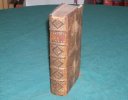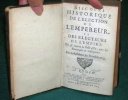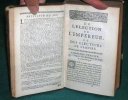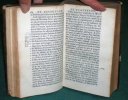WICQUEFORT Abraham de
Discours Historique de l'Election de l'Empereur, et des Electeurs de l'Empire.
Où est contenu la Bulle d'Or, avec les Remarques en conséquence. Par le Résident de Brandebourg.La Bulle d'or, parfois appelée bulle d'or de Nuremberg ou bulle d'or de Metz, est un texte essentiel du Saint-Empire romain germanique, promulgué par l'empereur Charles IV en 1356 à Metz. Elle donne à l'institution impériale sa forme définitive et attribue le choix du roi aux princes-électeurs. Elle tire son nom de la forme du document original, scellé par une Bulle en or métallique.A Rouen, Laurent Besongne; Nicolas Boucher; Antoine Maurry - 1711 - 612 pages.Reliure plein-veau de l'époque. Dos à nerfs orné et doré. Coiffe supérieure manquante. 2 coins émoussés. Pas de rousseur. Bon état. Format in-12°(17x11).
Reference : 15567
Bookseller's contact details
Livres et Collections P. Commerot
M. Philippe Commerot
8 allée des Acacias
92310 Sèvres
France
09 67 04 07 48
Payment mode



Sale conditions
Les livres sont expédiés le jour même de la réception du règlement. Vous pouvez passer vos commandes par mail, ou par téléphone. Règlements en euros, par carte bancaire, chèque français, virement bancaire, ou lien de paiement Stripe. Evitez paypal.
3 book(s) with the same title
Discours Historique de l'Élection de l'Empereur et des Électeurs de l'Empire. Par le Resident de Brandebourg.
A Paris, Chez Augustin Courbé, 1658. (16), 511 (misnumbered 519), (1) pp. 4to. Later full speckled calf, spine richly gilt with raised bands, gilt fillet on sides, marbled edges, small tear in lower front joint. BMSTC, French Books 1601-1700, B.33. First edition, dedicated to the French chancellor Séguier. Deals with the difficult electoral process in the Holy Roman Empire. During the interregnum between the death of Ferdinand III (1657) and the succession in 1658 by his son Leopold (who was king of Bohemia and Hongaria, but not Roman king) the author attempted to inform a French audiance by presenting a detailed history of and the principles by which the electoral process of the German emperor took place, explaining that the election of Holy Roman Emperor is the monopoly of seven princes of the Holy Empire, four of which are catholic and three of which are protestant. Each of these and their respective family are treated in this work outlining the history of each and with an explanation of their rights.Abraham de Wicquefort was born in Amsterdam in 1598, studied in Paris and became the official representative of the Margrave of Brandenbourg in Paris until he fell in disgrace with Mazarin who had him thrown into the Bastille in the year of publication of the present volume. - Leaf Xxiij with a tear in the outer blank margin. Very nice copy, from the Duc de la Rochefoucauld, author of the famous Maximes, and with a contemporary signature in the lower blank margin of the title-page and the stamp of the library at the Chateau Roche-Guyon in the blank outer margin of the title-page.


(NVVA, )
Phone number : 31 20 698 13 75
Discours historique de l'élection de l'empereur et des électeurs de l'Empire : où est contenu la Bulle d'or, avec les Remarques en conséquence. Par le Résident de Brandebourg.
Rouen chez Laurent Besongne & Antoine Maurry 1711 1 vol. relié in-12, basane fauve mouchetée, dos à nerfs avec pièce de titre de maroquin rouge et caissons ornés de dentelle dorée, armes dorées au centre du premier plat, tranches mouchetées, (16)-612 pp. Cet essai historique, nourri de nombreuses pièces originales traduites de l'allemand, parut pour la première fois en 1658. L'auteur (1606-1682), représentant de l'électeur de Brandebourg à la cour de France, publiera l'année de sa mort "L’ambassadeur et ses fonctions", l'un des premiers et grands textes de diplomatie. Quelques épidermures, sinon bonne reliure d'époque frappée aux armes et avec l'ex-libris gravé du marquis de Lajudie.
Discours historique de l'élection de l'empereur, et de l'origine des électeurs de l'Empire, avec la bulle d'or de Charles IV. et la capitulation de Joseph I. empereur dernier mort.
[sans lieu], [sans nom], 1711. In-12 de [4]-270p. demi-basane brune, dos à nerfs, pièce de titre verte, coiffe sup. accrochée (reliure 1900), tampon-ex-libris moderne.
 Write to the booksellers
Write to the booksellers




